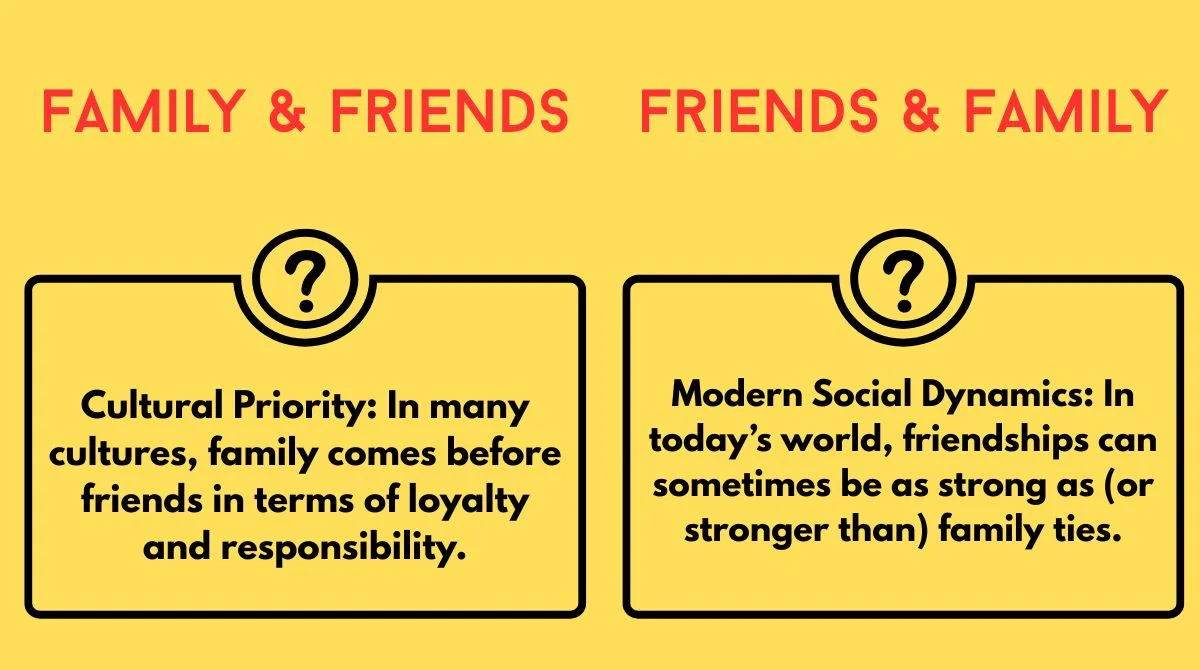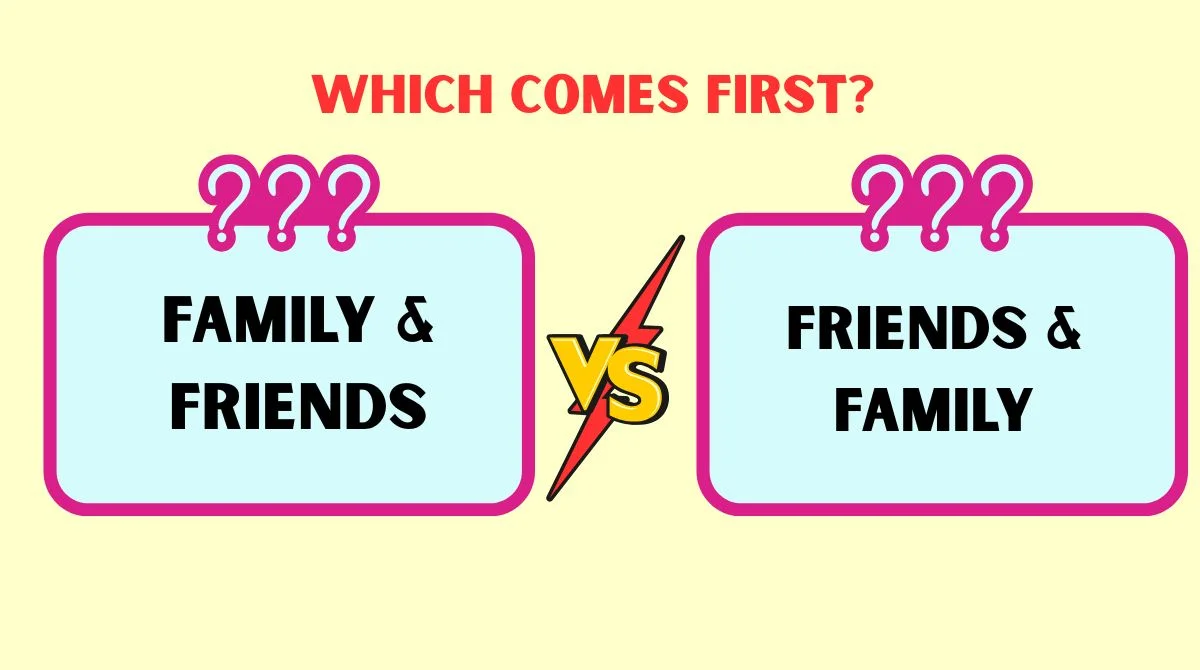Last updated on September 13th, 2025 at 11:27 am
Language is full of subtle nuances, and the order of words can carry hidden meanings.
A common question people ask is whether to say “Family & Friends” or “Friends & Family.” Does the order matter? Is one more correct than the other?
While both phrases are widely used, they have different connotations depending on context.
In this article, we’ll break down the linguistic, cultural, and etiquette-based considerations behind these expressions.
Should you say “Family & Friends” or “Friends & Family”? While both are correct, their order can subtly reflect cultural priorities, etiquette, and personal preferences. Learn which phrase to use and why!
The Great Debate: Order of Importance in Relationships

The way we arrange words often reflects how we prioritize things. Many people instinctively say “Family & Friends” because family is traditionally considered the most important unit of society.
Why Do People Say “Family & Friends” First?
- Cultural Priority: In many cultures, family comes before friends in terms of loyalty and responsibility.
- Emotional Connection: Parents, siblings, and relatives are often seen as a lifelong support system.
- Legal & Social Importance: Family members usually have more legal and financial responsibilities toward each other than friends do.
Why Do Some Prefer “Friends & Family”?
- Modern Social Dynamics: In today’s world, friendships can sometimes be as strong as (or stronger than) family ties.
- Marketing and Branding: Some businesses, particularly in hospitality, use “Friends & Family” because it sounds more inviting and inclusive.
- Personal Preference: Some people feel more emotionally connected to their friends and naturally put them first.
Key Takeaway: The phrase you choose can subtly reflect how you perceive relationships.
Grammatical Rules and Cultural Nuances
From a grammatical standpoint, both “Family & Friends” and “Friends & Family” are correct. However, English often follows specific patterns when listing words.
Does English Grammar Dictate the Order?
English has a tendency to follow an euphonic order, meaning words are arranged based on how pleasing they sound. Often, shorter words or those with fewer syllables come first.
- Example: “Salt and Pepper” (not “Pepper and Salt”)
- Example: “Bread and Butter” (not “Butter and Bread”)
However, “family” and “friends” have the same number of syllables, so euphony doesn’t play a major role here. Instead, cultural influence takes the lead.
Regional Preferences
- American English: “Family & Friends” is more common, emphasizing familial ties first.
- British English: Both variations are used interchangeably.
- Australian & Canadian English: Tends to follow American English but varies depending on context.
Key Takeaway: While there’s no strict grammar rule, culture and tradition shape the common preference.
Formal Salutations: How to Address Letters and Invitations
When writing formal invitations, event announcements, or professional letters, the order of “Family & Friends” or “Friends & Family” can make a difference.
Which One is More Appropriate?
- Weddings & Family Gatherings: “Family & Friends” is typically preferred since family is often considered the primary focus.
- Casual Events & Social Gatherings: “Friends & Family” may be used when the event is primarily social rather than family-centered.
Examples of Formal Salutations:
| Event Type | Preferred Greeting |
|---|---|
| Wedding Invitations | “Dear Family & Friends,” |
| Corporate Events | “Dear Friends & Family,” |
| Funeral Announcements | “To Our Beloved Family & Friends,” |
| Birthday Invitations | “To All Our Friends & Family,” |
Key Takeaway: The formality of the occasion influences the order of the phrase.
Understanding Salutation Etiquette
If you’re unsure which order to use in a salutation, consider the following etiquette tips:
- Prioritize Your Audience: If writing to family first, use “Family & Friends.” If addressing a friend-focused event, “Friends & Family” is acceptable.
- Consider the Occasion: Formal and traditional settings typically lean toward “Family & Friends.”
- Follow Social Norms: Look at common usage in similar invitations or documents to guide your choice.
- Personalize Your Greeting: When in doubt, address people by name for a more thoughtful touch.
Example Personalized Greeting:
“Dear Mom, Dad, and all our wonderful family & friends, we are excited to celebrate this special day with you!”
The Impact of Capitalization in Greetings
Capitalization plays a crucial role in clarity and professionalism when using “Family & Friends” or “Friends & Family” in written communication.
Should You Capitalize Both Words?
- Formal Writing (Invitations, Announcements): Yes.
Example: “We are delighted to invite our Family & Friends to celebrate with us.” - Casual or Personal Notes: Not necessary.
Example: “Looking forward to seeing all my family and friends soon!”
Incorrect Capitalization Mistakes to Avoid:
❌ “family & Friends”
❌ “Friends & family”
❌ “family and friends” (when used as a formal greeting)
Key Takeaway: Proper capitalization enhances readability and professionalism.
Historical and Modern Usage Trends
The order of “Family & Friends” vs. “Friends & Family” has evolved over time.
Historical Perspective
- In the 19th and early 20th centuries, traditional values emphasized the primacy of family, making “Family & Friends” the standard.
- In the mid-20th century, social movements emphasizing individuality and chosen relationships made “Friends & Family” a more common alternative.
Modern Usage Trends
- Marketing & Advertising: Businesses often use “Friends & Family” (e.g., “Friends & Family Discount”) to appear more inclusive.
- Social Media & Informal Settings: Both are used interchangeably, often depending on personal preference.
Key Takeaway: Language adapts to societal changes, and both versions remain widely accepted.
Alternatives to “Family & Friends” in Expressing Kinship
If you want to avoid the debate altogether, consider using alternative phrases:
Common Alternatives:
- Loved Ones (Example: “We invite all our loved ones to celebrate.”)
- Dear Ones (Example: “To our dear ones, we appreciate your support.”)
- Close Circle (Example: “Spending time with my close circle always brings joy.”)
- Community (Example: “Thank you to our community for being there.”)
- cohort (Example: “Grateful for my tribe and their unwavering love.”)
Choosing an alternative phrase can add warmth and inclusivity without worrying about order.
FAQs
Is “Family & Friends” more common than “Friends & Family”?
Yes, “Family & Friends” is more common, as family is traditionally considered more important in many cultures.
Why do some people say “Friends & Family” instead?
“Friends & Family” is often used in marketing, social events, and informal settings where friendships are emphasized.
Which phrase is better for invitations?
For weddings and formal gatherings, “Family & Friends” is preferred. For casual events, “Friends & Family” can work.
Does English grammar dictate the order of words?
Not strictly, but English often follows a natural order based on importance, euphony, or common usage.
Should both “Family” and “Friends” be capitalized?
Yes, in formal writing (e.g., invitations), both words should be capitalized: “Family & Friends.” In casual writing, lowercase is fine.
What are some alternatives to “Family & Friends”?
You can use “Loved Ones,” “Dear Ones,” “Close Circle,” or “Community” to avoid the debate and sound more inclusive.
Conclusion
So, should you say “Family & Friends” or “Friends & Family”? Ultimately, both are grammatically correct, but their usage depends on tradition, context, and personal preference.
- If emphasizing tradition and formality → “Family & Friends”
- If highlighting social bonds and inclusivity → “Friends & Family”
- If in doubt → Use an alternative phrase like “Loved Ones”
Understanding these nuances ensures you use the right phrase for the right situation, whether in invitations, greetings, or daily conversations.
What’s your preference—“Family & Friends” or “Friends & Family”? Let us know in the comments!
